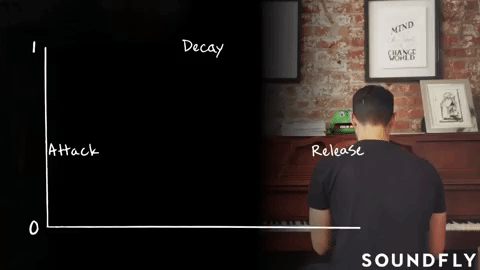+ Learn the nuances of producing beats, arranging tracks, and creative sampling, drawing on the rich history and influence of hip-hop in Soundfly’s acclaimed online course, The Art of Hip-Hop Production.
Have you ever found yourself working on a track that needs hard-hitting and punchy 808s, but just seems to fall short with a muddy low end instead? Getting 808s to cut through a mix may actually be easier than you think! Here are a few tips on how to do it.
Understanding the ADSR of an 808
ADSR (Attack, Decay, Sustain, Release) is an important concept to understand when working with 808s [for more about how attach, decay, sustain, and release work, check out our free course, Demystifying Synths: Envelope Generators.] . Specifically, we’ll be focusing on the “attack” and the “release.”
The attack is how quickly or abruptly the sound starts. A fast attack means it starts quickly, or even immediately, after hitting the note. A slow attack means that the note fades in and there’s not much punch to the start of the sound. The release is how quickly or slowly the sound fades out after the initial attack. A fast enough release will turn an 808 bass into a drum-like kick sound. You’ll want a pretty slow release in order to let it fade out and sound beefy in the low end.

Image via our free course Demystifying Synths: Envelope Generators
So why is it important to understand this for 808s?
If your 808s aren’t cutting through the mix, this is the first place to check. Try making the attack faster. This should make it cut through the mix more. If that doesn’t work (or if it’s already at an attack of 0 or the fastest it’ll go), try making the release faster. This means it should fade out faster.
While this may seem counter-intuitive to making big 808 sounds, think of it this way: By adding in more dynamics to the 808s, you’ll be able to turn up the entire track. This will make the transients of the 808 punch through more, while keeping the rest of it at a decent working level.
Adjusting Your Levels
If you’re confident that the ADSR is perfect and it’s still not cutting through the mix, try adjusting your levels. Bring other elements of the mix down in volume to allow the 808s more space to be heard.
Be careful not to lose sight of the focus in the mix. Sometimes it’s easy to let the 808s take over and throw the mix out of whack. Listen to some reference tracks that you like in order to make sure the levels are good for the low end.
Layering Kicks
If playing with the ADSR or levels of the 808s doesn’t do the trick, it’s time to try some layering options.
The first layer to try if you want more attack is to add a kick sample to the start of your 808 hits. Depending on the sound you’re after, you may want to try an 808 or 909-style kick drum. Or, you may be better off with an acoustic sounding kick drum with a lot of snap to it. Find a kick sound that you think blends well with the 808 you’re using, as well as with the rest of the track.
Remember, when layering sounds, you don’t necessarily need to be able to hear it. You just want to support the sounds that are already there.
Layering Other Basses
If all else fails, try layering other basses on top of the 808. Using a synth, like Serum, can be a great way to find bass sounds that blend well with 808s and add just the right amount of punch.
As I mentioned when discussing levels, make sure to step back and listen to the entire mix to make sure you’re not drowning out other elements with the bass. Whenever you blend two big synthy bass sounds together, it can get out of hand, balance-wise, if you’re not careful to step back and listen to the mix as a whole.
What do you like to do when you need your 808s to cut through the mix?
Any tips or tricks that you’ve found work well? Let us know in the comments below!
Subscribe to get unlimited access to all of our course content, an invitation to join our members-only Slack community forum, exclusive perks from partner brands, and massive discounts on personalized mentor sessions for guided learning. Learn what you want, whenever you want, with total freedom.
—
 PALA is a pop songwriter and producer with over a decade of experience. He has worked with many of the top organizations in music including the GRAMMY Foundation. His current project, PALA Sound Studio, features a brand new song every Friday. Many of his tracks start as collaborations on Splice – splice his projects and follow him here.
PALA is a pop songwriter and producer with over a decade of experience. He has worked with many of the top organizations in music including the GRAMMY Foundation. His current project, PALA Sound Studio, features a brand new song every Friday. Many of his tracks start as collaborations on Splice – splice his projects and follow him here.






